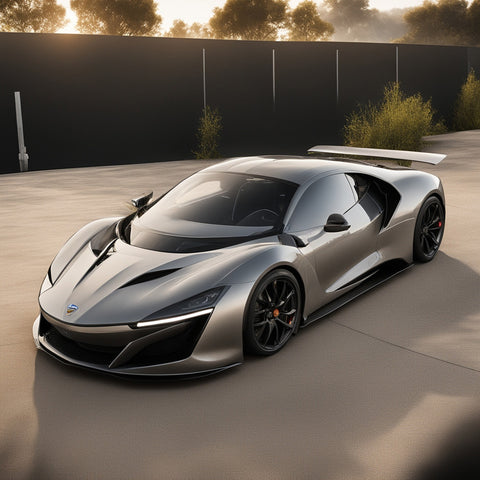In recent years, the automotive industry has undergone a significant shift towards embracing sustainability and eco-conscious practices. As concerns about climate change and environmental impact continue to grow, the concept of eco-friendly project cars has gained traction among automotive enthusiasts. These project cars not only serve as a canvas for personalization and creativity but also allow individuals to contribute to a greener and more sustainable future.
In this article, we delve into the world of eco-friendly project cars, exploring the latest sustainable modifications and practices that are shaping the automotive landscape in 2024. From electric conversions to performance upgrades and eco-conscious materials, we will uncover the innovative solutions and advancements that are driving the evolution of eco-friendly project cars.
As we enter a new era of automotive consciousness, it is crucial to understand the importance of sustainable modifications in reducing carbon emissions, minimizing environmental impact, and promoting a more responsible approach to car customization. By exploring these sustainable modifications, we aim to inspire and empower automotive enthusiasts to make eco-conscious choices when embarking on their own project car journeys.
Join us as we embark on a journey to discover the exciting world of eco-friendly project cars, where sustainability meets performance, style, and innovation. Together, we can explore the possibilities, push the boundaries of automotive customization, and contribute to a greener and more sustainable future.

I. The Evolution of Eco-Friendly Project Cars
A. Shift towards Electric and Hybrid Vehicles
In recent years, the automotive industry has witnessed a significant shift towards electric and hybrid vehicles. This transition is driven by a growing awareness of the environmental impact of traditional combustion engines and the need to reduce greenhouse gas emissions. Electric and hybrid vehicles offer a cleaner and more sustainable alternative, making them a popular choice among eco-conscious consumers.
The rise of eco-friendly project cars mirrors this shift, as enthusiasts embrace the challenge of converting and modifying conventional cars into electric or hybrid vehicles. By integrating electric powertrains and advanced battery systems, these project cars not only reduce reliance on fossil fuels but also showcase the potential for innovative and eco-friendly transportation solutions.
B. Benefits of Eco-Friendly Project Cars
One of the key advantages of eco-friendly project cars is their ability to reduce emissions. Electric and hybrid powertrains produce significantly lower or zero tailpipe emissions compared to traditional combustion engines. By adopting sustainable modifications, project car enthusiasts actively contribute to improving air quality and mitigating the environmental impact associated with transportation.
Furthermore, eco-friendly project cars often exhibit increased fuel efficiency. Electric vehicles, for instance, can travel longer distances on a single charge compared to their gasoline counterparts. This enhanced efficiency not only reduces the carbon footprint but also provides economic benefits, such as lower operating costs and decreased dependence on fluctuating fuel prices.
C. Advances in Renewable Energy Sources
The evolution of eco-friendly project cars is closely linked to the advances in renewable energy sources. As renewable energy technologies, such as solar and wind power, become more accessible and efficient, they offer new possibilities for powering electric vehicles. Project car enthusiasts are exploring innovative ways to integrate renewable energy systems into their vehicles, such as installing solar panels on the roof to generate clean energy for charging batteries.
Moreover, the availability of renewable energy sources impacts project car modifications beyond the power source. Sustainable materials derived from renewable resources, such as bamboo or recycled plastics, are being used for interior and exterior components. These materials not only reduce reliance on non-renewable resources but also contribute to a more sustainable and circular economy.
The evolution of eco-friendly project cars is driven by the global shift towards electric and hybrid vehicles, the benefits they offer in terms of reduced emissions and increased fuel efficiency, and the advancements in renewable energy sources. As enthusiasts embrace sustainable modifications, they play a vital role in demonstrating the potential of eco-friendly transportation and inspiring a more sustainable future for the automotive industry.

II. Sustainable Performance Upgrades
A. Enhancing Efficiency through Aerodynamic Modifications and Lightweight Components
When it comes to sustainable performance upgrades, one key focus is on improving efficiency. Aerodynamic modifications play a crucial role in reducing drag and improving airflow around the vehicle. By adding features like front splitters, rear diffusers, or side skirts, project car enthusiasts can optimize aerodynamics, resulting in improved fuel efficiency and reduced energy wastage.
In addition to aerodynamics, incorporating lightweight components is another effective way to enhance efficiency. By replacing heavy stock parts with lightweight alternatives made from materials like carbon fiber or aluminum, project car owners can decrease the overall weight of the vehicle. This reduction in weight leads to improved acceleration, handling, and fuel economy, while also minimizing environmental impact.
B. Optimizing Fuel Consumption with Advanced Engine Management Systems
Advanced engine management systems are a critical component of sustainable performance upgrades. These systems utilize advanced technologies, such as engine remapping or tuning, to optimize fuel consumption without sacrificing performance. By fine-tuning the engine parameters and optimizing the fuel-air mixture, project car owners can achieve a more efficient combustion process, resulting in improved fuel economy and reduced emissions.
In addition to engine management systems, hybrid powertrain conversions and regenerative braking systems are other examples of sustainable performance upgrades that optimize fuel consumption. Hybrid conversions allow for the integration of electric power alongside the combustion engine, providing additional power while reducing fuel usage. Regenerative braking systems capture and store energy that would otherwise be lost during braking, further improving overall efficiency.
C. Aftermarket Parts and Technologies for Performance and Sustainability
The aftermarket industry plays a crucial role in offering sustainable performance upgrades for project cars. Numerous aftermarket parts and technologies are designed to enhance both performance and sustainability. For example, high-flow air filters and exhaust systems allow for improved engine breathing, resulting in increased power output and reduced emissions.
Furthermore, the development of electric supercharger systems provides a sustainable alternative to traditional forced induction methods. These systems utilize an electric motor to compress air, providing instant power without relying on a traditional belt-driven supercharger or turbocharger. This innovative technology offers improved performance while minimizing carbon emissions.
Another example is the integration of start-stop systems, which automatically shut off the engine when idling and restart it when necessary. This feature reduces fuel consumption and emissions during stationary periods, such as traffic lights or prolonged stops. Project car enthusiasts can retrofit their vehicles with start-stop systems to enhance both performance and sustainability.
By showcasing these aftermarket parts and technologies, project car enthusiasts can explore sustainable performance upgrades that not only enhance the overall driving experience but also contribute to reducing environmental impact.
In summary, sustainable performance upgrades focus on enhancing efficiency through aerodynamic modifications and lightweight components, optimizing fuel consumption with advanced engine management systems, and integrating aftermarket parts and technologies that prioritize both performance and sustainability. By adopting these modifications, project car owners can enjoy improved performance while minimizing their ecological footprint.

III. Electric Conversions and Retrofits
A. Converting Traditional Combustion Engine Cars into Electric Vehicles
Converting traditional combustion engine cars into electric vehicles (EVs) is a complex yet exciting process that allows project car enthusiasts to embrace sustainable transportation. The conversion typically involves several key steps:
-
Removing the internal combustion engine: The first step is to remove the existing engine and related components from the vehicle, including the fuel system, exhaust system, and cooling system.
-
Installing an electric motor and controller: An electric motor, usually a brushless AC motor, is mounted in place of the removed engine. The motor is connected to a controller that manages the power flow and ensures smooth operation.
-
Adding a battery pack: A high-capacity battery pack is installed to store and supply electricity to the electric motor. The battery pack's capacity and configuration vary depending on the desired range and performance of the converted vehicle.
-
Upgrading the drivetrain and electronics: The drivetrain components, such as the transmission and differential, may need to be modified or replaced to accommodate the new electric powertrain. Additionally, the vehicle's electronics, including the wiring and control systems, are upgraded to integrate with the electric components.
-
Implementing charging infrastructure: Electric conversions require the installation of a charging system, including a charging port and appropriate charging equipment, to recharge the battery pack.
B. Benefits and Challenges of Electric Conversions for Project Cars
Electric conversions for project cars offer several benefits, including:
-
Environmental impact: By converting a traditional combustion engine car into an electric vehicle, project car enthusiasts significantly reduce greenhouse gas emissions and dependence on fossil fuels. This transition contributes to a cleaner and more sustainable transportation solution.
-
Performance and torque: Electric motors provide instant torque, delivering impressive acceleration and a smooth driving experience. Electric conversions can enhance the performance of project cars, allowing for exhilarating acceleration and improved handling.
-
Lower operating costs: Electric vehicles have lower fuel and maintenance costs compared to traditional cars. Electric conversions eliminate the need for gasoline, and the maintenance requirements for electric powertrains are generally simpler and less expensive.
However, there are also challenges associated with electric conversions:
-
Technical expertise: Electric conversions require a solid understanding of automotive engineering and electrical systems. Project car enthusiasts need to have the necessary knowledge or work with experienced professionals to ensure a successful conversion.
-
Availability of components: Electric conversion kits and components may be limited, depending on the specific make and model of the vehicle being converted. Finding compatible parts and ensuring their quality may pose challenges.
C. Successful Examples of Electric Retrofits and their Impact on Sustainability
Several successful examples of electric retrofits demonstrate the potential of electric conversions for project cars:
-
"White Zombie": A 1972 Datsun 1200 that underwent a famous electric conversion. The vehicle achieved impressive acceleration and became known as one of the fastest street-legal electric cars, showcasing the performance capabilities of electric retrofits.
-
"Electro-Metro": A converted Geo Metro, which became an iconic example of an affordable and practical electric vehicle. The conversion showcased how even small, economical cars could be transformed into sustainable electric transportation.
These successful electric retrofits highlight the impact of sustainable transportation choices and serve as inspiration for project car enthusiasts looking to embrace electric conversions.
In conclusion, electric conversions and retrofits offer project car enthusiasts the opportunity to transform traditional combustion engine cars into sustainable electric vehicles. Despite the challenges, the benefits of reduced environmental impact, improved performance, and lower operating costs make electric conversions an exciting avenue for those seeking sustainable transportation solutions.

IV. Eco-Friendly Materials and Interior Modifications
A. Sustainable Materials for Upholstery, Flooring, and Interior Trims
When it comes to eco-friendly interior modifications for project cars, utilizing sustainable materials is a key consideration. Here are some examples of sustainable materials suitable for upholstery, flooring, and interior trims:
-
Recycled or upcycled fabrics: Fabrics made from recycled materials, such as recycled polyester or nylon, offer a sustainable alternative for upholstery. Additionally, upcycled fabrics sourced from vintage or repurposed materials can add a unique and eco-friendly touch to the interior.
-
Vegan leather or plant-based alternatives: Traditional leather production can have a significant environmental impact. Opting for vegan leather, which is typically made from plant-based materials like cork, pineapple leaves, or mushroom leather, reduces the reliance on animal-derived products and minimizes environmental harm.
-
Sustainable wood or bamboo trims: Instead of using traditional wood trims sourced from endangered or unsustainable forests, project car enthusiasts can choose sustainable alternatives like bamboo or reclaimed wood. These materials provide a natural and stylish look while minimizing environmental impact.
-
Recycled or bio-based flooring materials: Carpets and floor mats made from recycled materials, such as recycled plastics or natural fibers like wool, offer sustainable options for project car interiors. Alternatively, bio-based materials like cork or natural rubber can be used for flooring, providing durability and a renewable resource.
B. Use of Recycled or Upcycled Materials in Project Car Interiors
In addition to sustainable materials, incorporating recycled or upcycled materials in project car interiors further promotes eco-friendliness. Here are some examples:
-
Recycled plastics: Interior trims, panels, and storage compartments can be made from recycled plastics. These plastics are typically sourced from post-consumer or post-industrial waste and help reduce the demand for virgin plastic production.
-
Upcycled automotive parts: Repurposing automotive parts, such as old steering wheels, shift knobs, or seat frames, not only adds a unique touch to the interior but also reduces waste. These upcycled parts can be refurbished or creatively integrated into the project car's interior design.
-
Recycled or reclaimed metal accents: Incorporating recycled or reclaimed metal accents, such as aluminum, copper, or stainless steel, can add a touch of elegance and sustainability to the interior. These materials can be sourced from salvaged or repurposed sources, reducing the need for new metal production.
C. Eco-Friendly Audio Systems, Navigation Systems, and Other Interior Modifications
When considering interior modifications, project car enthusiasts can opt for eco-friendly alternatives for audio systems, navigation systems, and other interior components. Here are some examples:
-
Energy-efficient audio systems: Choosing audio systems with energy-efficient amplifiers and speakers can reduce power consumption and minimize the impact on the vehicle's electrical system. Additionally, selecting audio components made from sustainable materials, such as bamboo speaker cones or recycled plastics, adds to the eco-friendly aspect.
-
Sustainable navigation systems: Utilizing navigation systems that prioritize energy efficiency and promote eco-friendly driving can assist in optimizing fuel consumption and reducing emissions. These systems may provide guidance on eco-friendly routes, charging station locations for electric vehicles, or real-time fuel efficiency feedback.
-
LED lighting: Upgrading interior lighting to energy-efficient LED bulbs significantly reduces power consumption compared to traditional incandescent or halogen bulbs. LED lighting also has a longer lifespan, reducing waste from frequent bulb replacements.
-
Efficient climate control systems: Installing energy-efficient climate control systems, such as smart thermostats or systems with low power consumption, can help minimize energy usage and improve overall efficiency.
By incorporating these eco-friendly audio systems, navigation systems, and other interior modifications, project car enthusiasts can create sustainable and environmentally conscious interiors.
In conclusion, eco-friendly materials, recycled or upcycled components, and sustainable interior modifications offer project car enthusiasts the opportunity to create stylish and environmentally friendly vehicle interiors. By choosing sustainable materials, repurposing automotive parts, and selecting energy-efficient components, project car owners can showcase their commitment to sustainability and contribute to a greener future.

VI. Eco-Conscious Exterior Upgrades
A. Eco-Friendly Paint Options
When it comes to eco-conscious exterior upgrades for project cars, choosing the right paint options can make a significant difference. Here are some eco-friendly paint alternatives:
-
Water-based paints: Water-based paints use water as the primary solvent instead of traditional petroleum-based solvents. They have lower levels of volatile organic compounds (VOCs) and hazardous air pollutants, making them a more environmentally friendly choice. Water-based paints also offer excellent color accuracy and durability.
-
Low VOC paints: VOCs are chemicals that can be released into the air during the paint application and drying process, contributing to air pollution and potential health risks. Low VOC paints contain significantly lower levels of VOCs compared to conventional paints, making them a greener option. These paints are available in a wide range of colors and finishes.
-
Powder coatings: Powder coatings are a dry finishing process where powdered pigments are electrostatically applied to metal surfaces and then cured through heat. Powder coatings are solvent-free and produce minimal waste, making them an environmentally friendly alternative to traditional liquid paints. They provide excellent durability and resistance to corrosion.
B. Sustainable Alternatives to Chrome Plating and Exterior Finishes
Chrome plating and other traditional exterior finishes often involve the use of toxic chemicals and have a significant environmental impact. Here are some sustainable alternatives:
-
Water-based or powder-coated finishes: As mentioned earlier, water-based or powder-coated finishes can be used instead of chrome plating. These finishes offer durability, resistance to corrosion, and a wide range of color options without the environmental drawbacks of chrome plating.
-
Anodized finishes: Anodizing is an electrochemical process that creates a protective oxide layer on metal surfaces. It can provide a lustrous and durable finish that is resistant to corrosion. Anodized finishes are available in various colors and can be a sustainable alternative to chrome plating.
-
Sustainable wraps and films: Vinyl wraps and films are increasingly popular for exterior customization. Opting for wraps made from sustainable materials, such as those with low VOC content or recyclable options, can reduce environmental impact while still allowing for creative customization of the vehicle's appearance.
C. Importance of Proper Maintenance and Care
Proper maintenance and care are essential for minimizing the environmental impact of project cars. Here are some considerations:
-
Regular cleaning and detailing: Keeping the exterior clean and free from dirt, grime, and contaminants not only enhances the vehicle's appearance but also helps maintain the integrity of the paint or finish. Choose eco-friendly car cleaning products that are biodegradable and do not contain harmful chemicals.
-
Responsible waste disposal: When performing maintenance, ensure that any waste, such as used fluids, filters, or parts, is disposed of properly. Recycle or dispose of these materials in accordance with local regulations to prevent pollution and minimize environmental harm.
-
Sustainable water usage: When washing the car, consider water-saving practices, such as using a bucket instead of a hose, or utilizing waterless car wash products that require minimal water. This helps conserve water resources and reduces runoff pollution.
-
Eco-friendly detailing products: When applying waxes, polishes, or sealants, choose environmentally friendly products that are free from harmful chemicals and have minimal impact on ecosystems.
By adopting proper maintenance practices and using eco-friendly products, project car enthusiasts can ensure their vehicles have a reduced environmental footprint and contribute to a more sustainable automotive culture.
In conclusion, eco-conscious exterior upgrades for project cars involve selecting eco-friendly paint options, exploring sustainable alternatives to chrome plating, and practicing proper maintenance and care. By choosing water-based or low VOC paints, opting for sustainable finishes, and adopting responsible maintenance practices, project car owners can enhance the appearance of their vehicles while minimizing their environmental impact.

VI. Electric Conversions and Retrofits
A. Converting Traditional Combustion Engine Cars into Electric Vehicles
Converting a traditional combustion engine car into an electric vehicle (EV) involves several key steps. Here is an overview of the process:
-
Vehicle evaluation: The first step is assessing the feasibility of the conversion. Factors such as the vehicle's weight, available space for batteries, and overall condition need to be considered. Some vehicles may be better suited for conversion due to their design and compatibility with electric drivetrains.
-
Removal of combustion engine components: The internal combustion engine, fuel system, exhaust system, and related components are removed from the vehicle. This creates space for the electric motor, battery pack, and other EV components.
-
Electric motor and transmission installation: An electric motor, typically a permanent magnet AC motor or an induction motor, is installed in place of the combustion engine. The motor is connected to the transmission or directly to the drivetrain, depending on the vehicle's configuration.
-
Battery pack installation: A high-capacity battery pack is installed in the vehicle, typically in the trunk, under the seats, or in other available spaces. The battery pack provides the necessary energy to power the electric motor.
-
Controller and charging system integration: An electronic controller manages the power flow between the battery pack and the motor, allowing for precise control of acceleration, regenerative braking, and other functions. A charging system is also integrated to enable recharging the battery pack from external power sources.
-
Wiring and safety considerations: The electrical wiring is modified to accommodate the new EV components. Safety features such as high-voltage disconnect systems, thermal management systems, and fire suppression systems may also be installed to ensure safe operation.
-
Testing and fine-tuning: Once the conversion is complete, the vehicle undergoes extensive testing to ensure all systems function properly. Fine-tuning may be necessary to optimize performance, range, and overall efficiency.
It's important to note that converting a traditional car to an electric vehicle is a complex process that requires expertise in automotive engineering and electrical systems. It is recommended to consult with professionals or specialized conversion companies for successful conversions.
B. Benefits and Challenges of Electric Conversions for Project Cars
Electric conversions for project cars offer several benefits, but they also come with challenges. Here are some key points to consider:
Benefits:
-
Environmental impact: Electric conversions significantly reduce greenhouse gas emissions and dependence on fossil fuels. By converting a combustion engine car to electric, project car enthusiasts can contribute to a cleaner and more sustainable transportation system.
-
Performance and efficiency: Electric motors offer instant torque, providing excellent acceleration and a smooth driving experience. Electric conversions can also result in increased energy efficiency and reduced operating costs compared to traditional combustion engines.
-
Customization possibilities: Electric conversions allow for unique customization opportunities. Enthusiasts can incorporate modern technology, such as regenerative braking systems, advanced vehicle control systems, and smart connectivity features, into their project cars.
Challenges:
-
Cost: Electric conversions can be expensive, primarily due to the high cost of battery packs and specialized components. The overall cost will depend on the complexity of the conversion and the desired performance and range.
-
Technical expertise: Converting a car to electric requires specialized knowledge of automotive engineering, electrical systems, and EV technology. It may be challenging for individuals without the necessary expertise to perform the conversion themselves.
-
Weight and space limitations: Electric drivetrain components, especially battery packs, can be heavy and may require modifications to the vehicle's structure or suspension. Limited space within the vehicle may also pose challenges when finding suitable locations for the components.
C. Successful Examples of Electric Retrofits and Their Impact on Sustainability
Several successful examples of electric retrofits have demonstrated the feasibility and impact of converting traditional cars into electric vehicles:
-
The "eDub" VW Beetle: The Electric Classic Cars company in the UK converted a classic VW Beetle into an electric vehicle. The conversion maintained the original charm of the Beetle while offering zero-emission driving and improved performance.
-
"e-Drive Retro" Porsche 911: The e-Drive Retro project in the Netherlands converted a classic Porsche 911 into an electric sports car. The conversion showcases how electric power can enhance the performance and driving experience of a beloved vintage car.
-
"e-Box" Ford Mustang: The Charge Automotive company in the UK retrofitted classic Ford Mustangs with electric powertrains. The conversions retain the iconic muscle car aesthetics while providing the benefits of electric propulsion.
These successful electric retrofits demonstrate the potential of converting project cars into electric vehicles, combining sustainability with classic automotive design and performance.
In conclusion, electric conversions and retrofits offer project car enthusiasts the opportunity to transform traditional combustion engine vehicles into eco-friendly and high-performance electric vehicles. While the conversion process requires expertise and investment, the benefits include reduced emissions, improved efficiency, and unique customization possibilities. Successful examples of electric retrofits showcase the potential of sustainable transportation while preserving the appeal of classic and vintage cars.

VII. Connecting with the Eco-Friendly Project Car Community
A. Online Forums, Social Media Groups, and Events
The eco-friendly project car community has grown significantly in recent years, and there are various platforms and events dedicated to connecting enthusiasts. Here are some ways to connect with the community:
-
Online forums: Online forums provide a platform for enthusiasts to share knowledge, ask questions, and discuss eco-friendly project car topics. Websites such as Electrifying.com, ElectricVehicleWeb.in, and DIY Electric Car Forums have dedicated sections for electric vehicle conversions and sustainable automotive projects.
-
Social media groups: Social media platforms like Facebook and Reddit have communities and groups focused on eco-friendly project cars. Joining these groups allows enthusiasts to interact with like-minded individuals, share experiences, and seek advice. Examples include the "EV Conversions" group on Facebook and the "r/EVConversion" subreddit.
-
Events and meetups: Attend eco-friendly automotive events and meetups to connect with fellow enthusiasts in person. These gatherings often feature displays of electric and sustainable vehicles, guest speakers, and networking opportunities. Look for events like the EV Conversion Convention, Electric Vehicle Symposium (EVS), or local meetups organized by EV owners' clubs or sustainability organizations.
B. Importance of Sharing Knowledge and Experiences
Sharing knowledge and experiences within the eco-friendly project car community is crucial for the growth and advancement of sustainable automotive initiatives. Here's why it's essential:
-
Learning from others: By sharing experiences, enthusiasts can learn from each other's successes and challenges. This knowledge exchange can help individuals avoid common pitfalls, gain insights into different conversion techniques, and discover innovative solutions.
-
Problem-solving and troubleshooting: Project car conversions often involve unique situations and technical challenges. Engaging with the community allows enthusiasts to seek advice and collaborate on finding solutions to specific issues. The collective wisdom of the community can provide valuable guidance in overcoming obstacles.
-
Inspiring and motivating others: When enthusiasts share their successful eco-friendly projects, they inspire and motivate others to embark on similar journeys. By showcasing the possibilities and benefits of sustainable automotive modifications, the community can encourage more individuals to adopt eco-friendly practices.
C. Connecting with Like-Minded Enthusiasts and Learning from Sustainable Projects
Connecting with like-minded enthusiasts and learning from their sustainable projects can be an enriching experience. Here's how you can get involved:
-
Join online communities: Participate in online forums and social media groups dedicated to eco-friendly project cars. Engage in discussions, ask questions, and contribute your knowledge and experiences. This interaction will help you connect with enthusiasts who share your passion for sustainability.
-
Attend events and meetups: Look for local events, car shows, or meetups focused on eco-friendly vehicles and conversions. Attend these gatherings to meet fellow enthusiasts, see their projects firsthand, and engage in conversations about sustainable automotive practices.
-
Collaborate on projects: If you come across a project that aligns with your interests, reach out to the individual or group involved. Offer assistance, share resources, or propose collaborative efforts. By working together, you can collectively contribute to the development of eco-friendly project cars and build a stronger community.
-
Document and share your own project: If you are working on an eco-friendly project car, document your progress and share it with the community. Post updates on online platforms, create a blog, or contribute articles to relevant publications. By sharing your journey and insights, you can inspire others and foster knowledge exchange.
Remember, the eco-friendly project car community is built on a foundation of collaboration and shared enthusiasm. By actively engaging with the community, you can expand your knowledge, contribute to sustainable automotive initiatives, and forge meaningful connections with like-minded individuals.

The world of eco-friendly project cars offers enthusiasts a unique opportunity to combine their passion for automotive customization with a commitment to sustainability. Converting traditional combustion engine cars into electric vehicles not only reduces emissions but also unlocks a range of benefits such as improved performance, energy efficiency, and customization possibilities. While the process of electric conversions may be complex and require technical expertise, connecting with the eco-friendly project car community can provide invaluable support, knowledge sharing, and inspiration.
Through online forums, social media groups, and events dedicated to eco-friendly project cars, enthusiasts can connect with like-minded individuals, learn from their experiences, and contribute to the collective growth of sustainable automotive initiatives. Sharing knowledge and experiences within the community is essential for problem-solving, troubleshooting, and fostering innovation. By showcasing successful electric retrofits and sustainable projects, enthusiasts can inspire others to embrace eco-friendly practices and contribute to a cleaner and greener transportation future.
In conclusion, the eco-friendly project car community represents a vibrant and evolving space where automotive enthusiasts can merge their love for cars with a commitment to sustainability. By connecting with others, learning from their projects, and sharing experiences, individuals can play an active role in advancing eco-friendly automotive conversions and contribute to a more sustainable and environmentally conscious future.

